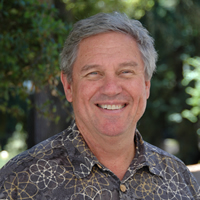
Though we don't know who actually built the first telescope in the early 17th century, Galileo was the first to use and develop the instrument into a serious scientific tool for astronomy. His innovations opened a new window on the universe for humankind. But by the 20th century, it seemed that the optical telescope had reached its pinnacle of development in 1948 with the 200-inch Hale Telescope on Mount Palomar in California. Most people, including astronomers, thought that it would be physically impossible to ever build a bigger, more powerful telescope than that magnificent instrument.
It took Jerry Nelson to prove them wrong fewer than fifty years later. He devised a wholly new telescope design, a daring, revolutionary notion with at least a thousand reasons why it shouldn't and couldn't work—yet Nelson showed that it did. In doing so, he enabled an entirely new generation of powerful and sensitive optical ground-based telescopes to be built, capable of peering more deeply into the universe than ever before possible.
It's quite an impressive achievement for any scientist, but particularly one who began his career not as an astronomer, but as a high-energy particle physicist. Nelson earned his B.S. in physics in 1965 from Caltech (where he helped to design and build a 1.5 meter diameter telescope) and a doctorate in particle physics from the University of California, Berkeley in 1972. In 1977, while Nelson was working as a physicist at Lawrence Berkeley National Laboratory, he became part of a committee formed to study the possibility of building a new large telescope as the next step beyond the Hale.
The heart of a large astronomical telescope such as the Hale is its reflecting mirror—the larger the mirror, the more light it can gather, and the more the telescope can see. But while in theory the mirror can be as big as desired, there are physical limits. Bigger mirrors are heavier and thus more difficult to transport and handle, and more prone to optical distortions. The problems increase exponentially with size: if the diameter of the mirror is doubled, its thickness must be quadrupled just to support its own weight. Nelson's committee quickly realized that creating a single piece of finely-crafted and shaped glass much beyond the 200-inch diameter of the Hale mirror was simply not practical.
Instead, Nelson came up with an ingenious alternative: using an array of smaller segmented mirrors, actively synchronized in real time by a sophisticated electronic control system, working in effect as a single mirror. Because each mirror segment could be small and thin and thus lightweight, the effective diameter of the mirror could be made much larger than a single huge piece of glass.
It was an elegant and simple concept that posed some enormous practical technological challenges. Each segment would have to be precisely shaped to act not as an optically spherical individual mirror, but in such a way to form a much larger optically correct single unit. To achieve this, Nelson invented the technique of "stressed mirror polishing," in which each segment was mechanically bent "out of shape" to a point at which it could be spherically polished, then released to reform itself back into the desired shape.
The other major technological hurdle of the segmented mirror concept was to ensure that each piece would work together seamlessly, staying in perfect alignment even while in motion, to function as a single surface. If segments were out of phase by even a fraction of a wavelength, the mirror would be useless. Nelson and his team created an intricate system of sensors and mechanical servo actuators to integrate the mirror segments under computer control.
By 1979, Nelson's committee had finalized its radically innovative concept, and in 1985 the Keck Foundation provided funds to make it a reality by constructing the Keck I and II segmented mirror telescopes on Mauna Kea in Hawaii. Since the Keck Observatory was completed and began operation in the early 1990s, it has become one of the world's major centers of science, its state-of-the-art instruments defining and dominating astronomical research and discovery.
Though it first seemed odd and unworkable, Nelson's segmented mirror concept has ushered in a brand new era in ground-based astronomy, with the construction of several new large telescopes based on the design. One of these is the Thirty-Meter Telescope (TMT), planned as the first of a new generation of ELTs (Extremely Large Telescopes) for the 21st Century. Nelson is currently serving as project scientist on the TMT, which will be triple the size of his Keck instruments. But even before the TMT sees first light, Nelson's segmented mirrors will also revolutionize space-based astronomy when the James Webb Space Telescope, the much larger successor to the Hubble Space Telescope, is launched later this decade. Although he joined the faculty of University of California, Santa Cruz in 1994, he continues to serve as a project scientist for the Keck Observatory and as a consultant on telescope design and adaptive optics for other projects. His many professional honors include election to the National Academy of Sciences in 1996, the Andre Lallemand Prize of the French Academy of Sciences, and the Fraunhofer Award/Robert M. Burley Prize of the Optical Society of America.
Both on the ground and in space, Jerry Nelson has transformed the telescope in ways that even Galileo could never have imagined, and vastly expanded the ability of humanity to see and understand the universe.
Information as of April 2012

